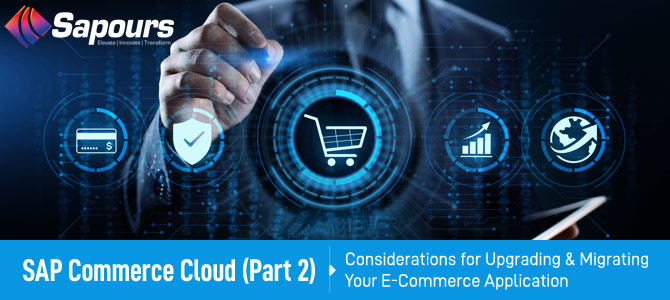Upgrading or migrating to the newer versions of SAP Commerce Cloud is one of the best decisions you can make to accommodate operational flexibility, scalability, and adherence to demographic requirements.
Commerce Cloud’s prominence over on-prem or traditional SAP solutions is evident owing to better front-end purchase experience capabilities, on-demand scalability assistance, and advanced data analytics options.
Part 1 of this series covered everything about what upgrading and migrating to SAP Commerce Cloud means and what benefits it accrues in the context of your business requirements.
Read more here: SAP Commerce Cloud – Part 1 – Upgrade and Migrate – Need of the hour
Now that you’re planning on upgrading or migrating your eCommerce solution to SAP Commerce Cloud, let’s look at some of the things you should note before committing to the process.
Set Up the Communication Channels
The team responsible for the upgrade or migration process should be in constant touch with the teams responsible for maintenance and support of the current system. Failure to communicate through an organized communication channel can be detrimental to the project’s success.
At the same time, the upgrade team must touch base with the customer to understand the implications of the change, comprehend the preferred (desired) usage of the application, and ensure that the transition is as seamless as possible. This could be facilitated by setting up chat groups on Slack and the likes.
Fostering an efficient communication system also entails defining the roles and responsibilities in place. This way, everyone is aware of the various inputs they are required to deliver at each project stage.
For instance, you must have a SAP CX partner to steer the process from the get-go. They’d be responsible for solution delivery and project management courtesy of various specifically defined profiles working in tandem – lead manager, project manager, upgrade lead, upgrade engineer, QA manager, lead business analyst, and technical architect.
Plan for Everything – Define a Roadmap
“Everything” might sound intimidating, but that’s the point of realizing the intricacies of the current environment to prepare for the upgrade and plan ahead.
Assess your current technology stack, processes and procedures, preferred business objectives and timelines, and the type of version upgrade or migration you’d want to go forward with. Questions like these could give you the gist:
- Do you need to set up the testing environments? If yes, how much time will this consume?
- How many parties are involved? (The nature of collaboration would influence the time it takes to deploy and support)
- What releases is SAP planning to roll out in the next few months, and how will they influence your upgrade?
- When should a particular feature be ready for use, and how much leeway can the team afford to deploy it?
- Is data migration isolated from the code upgrade process? Why is it necessary?
- What are the expected benefits sourcing from the upgrade?
- Can you practice dry runs to understand the operation in real-time? If yes, how will you be able to test out all possible scenarios?
Don’t Overlook the Deprecated Status
Every new release brings in added functionality, and they should be evaluated in entirety before final implementation. However, at the same time, the upgrade team must consider features that will not be a part of the newer releases. This could be because of deprecated usage or because SAP wants you to opt for modern features relevant to the business objectives.
SAP announces the de-release of modules/extensions way in advance so that users can make the best decision without being too dependent on them.
In some situations, having such a module or extension in the mix helps for that point in time. But you need to ask yourself if there’s a place for it in the new development practice. And if not, are there any alternatives?
Ensure that Data Migration Is Focused on the Right Things
Data migration is a critical aspect of any upgrade. Understanding the data in your application and its interactions with other systems will help you focus on a core set of data points that need to be migrated.
In most cases, you’ll have to follow a series of best practices:
- Review the gap between the current system and the future state to realize the scale of data migration to be accommodated
- Assess the timeframe for the migration, including the period for data cleansing
- Evaluate ways to modify the data. At times, a simple script could work better for database modification than a full-scale update
Document Everything: Operational Procedures, Related System Scenarios, Availability, and Criticality
Technical documentation that includes all the details about the systems and their interconnectivity can help consolidate all the information:
- The upgrade or migration team would need to understand a solution before it is implemented
- The support team would need to recover a failed solution
- The business team would require to repurpose the software architecture that doesn’t function as per your expectations
Code and Test
Efficient coding would entail reviewing the technical upgrade documentation released by SAP pertaining to the specific version release. It would also require running baseline Sonar tests, defining security, driving configurations, and identifying dependencies.
Concurrently, the team would need to be thoroughly familiar with the tested environments and their interactions. Running acceptance tests and manual validation should suffice for this.
You’d also likely want to consider running a more intensive set of tests and validation procedures for advanced scenarios while creating a staged rollout.
The Bottom Line
All the above considerations are meant to ensure that your upgrade or migration is a smooth and error-free experience. But what would matter most is how team members collaborate and work together to find out the best plan of action.
Book a consultation with us and learn more about how we can help you upgrade or migrate to the latest version of SAP Commerce Cloud and stay competitive in times to come!

